
The Devonian is a geologic period and system of the Paleozoic, spanning 60.3 million years from the end of the Silurian, 419.2 million years ago (Mya), to the beginning of the Carboniferous, 358.9 Mya. It is named after Devon, England, where rocks from this period were first studied.

Corals are marine invertebrates within the class Anthozoa of the phylum Cnidaria. They typically form compact colonies of many identical individual polyps. Coral species include the important reef builders that inhabit tropical oceans and secrete calcium carbonate to form a hard skeleton.

The Bay of Pigs is an inlet of the Gulf of Cazones located on the southern coast of Cuba. By 1910, it was included in Santa Clara Province, and then instead to Las Villas Province by 1961, but in 1976, it was reassigned to Matanzas Province, when the original six provinces of Cuba were re-organized into 14 new Provinces of Cuba.
William Lonsdale, English geologist and palaeontologist, won the Wollaston medal in 1846 for his research on the various kinds of fossil corals.
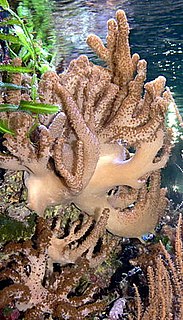
Alcyonacea, or soft corals, are an order of corals. In addition to the fleshy soft corals, the order Alcyonacea now contains all species previously known as "gorgonian corals", that produce a more or less hard skeleton, though quite different from "true" corals (Scleractinia). These can be found in suborders Holaxonia, Scleraxonia, and Stolonifera. They are sessile colonial cnidarians that are found throughout the oceans of the world, especially in the deep sea, polar waters, tropics and subtropics. Common names for subsets of this order are sea fans and sea whips; others are similar to the sea pens of related order Pennatulacea. Individual tiny polyps form colonies that are normally erect, flattened, branching, and reminiscent of a fan. Others may be whiplike, bushy, or even encrusting. A colony can be several feet high and across, but only a few inches thick. They may be brightly coloured, often purple, red, or yellow. Photosynthetic gorgonians can be successfully kept in captive aquaria.

Precious coral, or red coral, is the common name given to a genus of marine corals, Corallium. The distinguishing characteristic of precious corals is their durable and intensely colored red or pink-orange skeleton, which is used for making jewelry.

Orbicella annularis, commonly known as the boulder star coral, is a species of coral that lives in the western Atlantic Ocean and is the most thoroughly studied and most abundant species of reef-building coral in the Caribbean to date. It also has a comprehensive fossil record within the Caribbean. This species complex has long been considered a generalist that exists at depths between 0 and 80 meters that grew into varying colony shapes in response to differing light conditions. Only recently with the help of molecular techniques has O. annularis been shown to be a complex of at least three separate species. Those species are divided into O. annularis, O. faveolata, and O. franksi. This coral was originally described as Montastraea annularis.
The International Coral Reef Society is an international, not-for profit, scientific society dedicated to the conservation of coral reefs through science and understanding. Founded in 1980, the primary objective of ICRS is the improvement of scientific knowledge and understanding of coral reefs, both living and fossil.

Favosites is an extinct genus of tabulate coral characterized by polygonal closely packed corallites. The walls between corallites are pierced by pores known as mural pores which allowed transfer of nutrients between polyps. Favosites, like many corals, thrived in warm sunlit seas, feeding by filtering microscopic plankton with their stinging tentacles and often forming part of reef complexes. The genus had a worldwide distribution from the Late Ordovician to Late Permian.
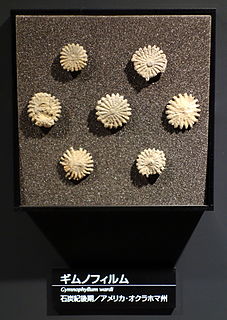
Gymnophyllum wardi, commonly known as button coral, is an extinct coral from the Pennsylvanian part of the Carboniferous period. The fossils are found in relatively few places worldwide; most specimens are known from the upper part of the Wewoka formation in and around Lake Okmulgee in Okmulgee State Park or the adjoining Dripping Springs State Park in Okmulgee County, Oklahoma in the United States.
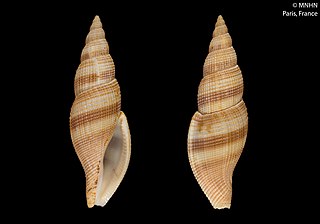
Metula is a genus of sea snails, marine gastropod molluscs in the family Colubrariidae.

Helioporacea is an order of the subclass Octocorallia that forms massive lobed crystalline calcareous skeletons in colonial corals. These corals first appeared in the Cretaceous period. It consists of two families, Helioporidae Moseley, 1876 and Lithotelestidae Bayer & Muzik, 1977.

Lithostrotion is a genus of rugose coral which is commonly found as a fossil within Carboniferous Limestone. Lithostrotion is a member of the family Lithostrotionidae. The genus Lithostrotion, a common and readily recognised group of fossils, became extinct by the end of the Palaeozoic era.

Isastrea is an extinct genus of corals that lived during the Jurassic and Cretaceous periods. Its fossils have been found in Europe, Africa, North America, Asia and South America.
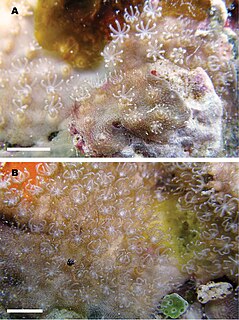
Lithotelestidae is a family of coral in the order Helioporacea. It was erected in 1977 by Frederick Bayer and Katherine Muzik. It is characterized by a crystalline aragonite skeleton formed by stolons and calices, cylindrical calices with secondary lateral calices, and fully retractable polyps with an exoskeleton formed of calcite capstans and crosses.
Taiaroa is a genus of deep-water, solitary marine octocorals in the family Taiaroidae. Taiaroa is monotypic in the family Taiaroidae and contains a single species, Taiaroa tauhou. The species was first described by the marine zoologists Frederick M. Bayer and Katherine Margaret Muzik in 1976. The scientific name derives from "Taiaroa", the submarine canyon off New Zealand in which the first specimens were found and "tauhou", the Maori word for "strange".
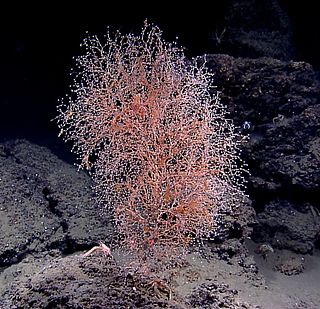
Chrysogorgiidae is a family of soft corals in the suborder Calcaxonia.
Holocystis is a genus of prehistoric stony corals.

Heteropsammia is a genus of apozooxanthellate corals that belong to the family Dendrophylliidae.

Porites lutea is a species of stony coral in the family Poritidae. It is found growing in very shallow water on reefs in the Indo-Pacific region. It sometimes forms "microatolls" in the intertidal zone and these massive structures have been used to study trends in sea levels and sea water temperature.
















